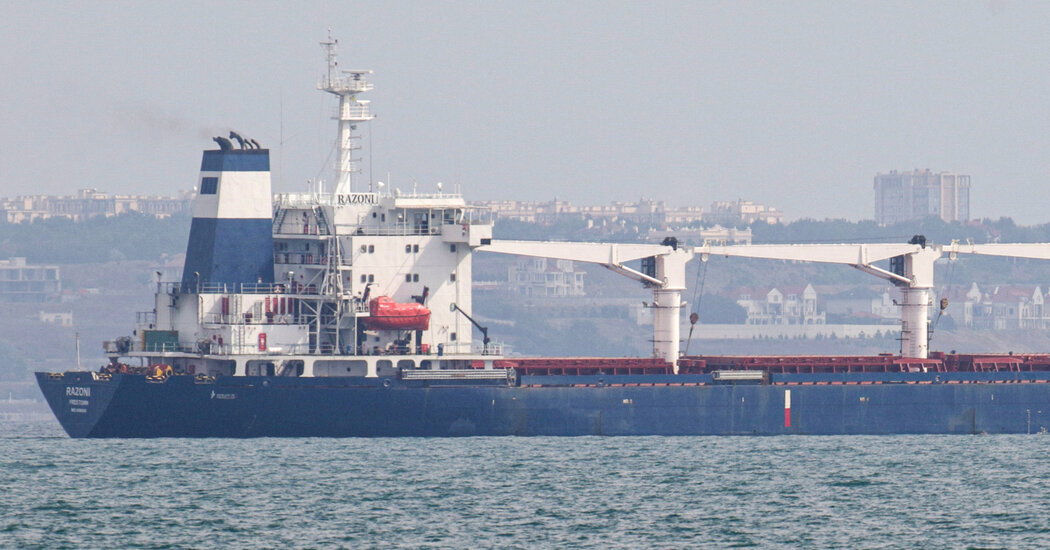As a grain shipment heads to Lebanon, fighting intensifies on many fronts.

A ship loaded with Ukrainian corn was heading for an inspection in Turkish waters on Tuesday, a first under the provisions of a recent grain deal that opened Ukrainian ports for export after five months of a wartime Russian blockade.
If the voyage goes smoothly, and the ship reaches its delivery destination — the Port of Tripoli in Lebanon — it would represent a significant step toward restoring the flow of grain from Ukraine, one of the world’s breadbaskets before the war. That would help ease grain shortages and lower prices around the world, though it cannot alone resolve the causes of the current global hunger crisis, which include conflicts elsewhere and climate disruptions.
But the grain deal, which took months to negotiate, could easily unravel. The ship, the Razoni, is traveling through a war zone, at risk of an attack or accident, and a breach of trust or disagreement among inspectors and officials from the four parties to the arrangement — Ukraine, Russia, the United Nations and Turkey — could once again freeze ships in ports.
And even as the Razoni’s Black Sea crossing raised hopes for some degree of cooperation between the combatants, the fighting intensified on multiple fronts in Ukraine.
Preparing for a counteroffensive in the southern Kherson region, Ukraine has used long-range precision weapons, recently supplied by the West, to disrupt Russian supply lines and logistics. Ukrainian forces have been attacking Russian command and control centers, hitting supply routes, trying to isolate Russian forces into pockets and enlisting Ukrainian saboteurs behind enemy lines.
On Monday, Ukrainian officials said that, using American-supplied rocket artillery, their forces had blown up a Russian train carrying troops and equipment to reinforce positions in southern Ukraine, killing dozens of soldiers and destroying many rail cars.
“According to intelligence data, all the drivers and engineers of the Russian Railways company, who were transporting military cargo from Crimea to the Kherson region, were killed,” Anton Gerashchenko, an adviser to the Ministry of Internal Affairs, said.
Although his claims could not be independently verified, video of an explosion and satellite imagery of the aftermath offered evidence that the Ukrainians had struck a Russian train along one of two main rail lines running from Crimea to southern Ukraine.
The Ukrainian military also said Monday that it had in recent weeks destroyed at least 15 ammunition depots in the south, affecting supplies enough to force Russia to use surface-to-air missiles to strike ground targets.
The Pentagon said last week that Ukraine was using Western weapons to increasing effect. On Monday, the Biden administration announced another round of support for Ukraine: $550 million in military aid, including more ammunition for 155-millimeter Howitzer artillery pieces and High Mobility Artillery Rocket Systems, or HIMARS, that the United States has already provided.
But for all its sluggish or faltering progress in the war, Russia retains vast advantages in the size of its arsenal, and it is now pursuing a strategy that enabled the conquest of Luhansk Province in the east, blanketing towns with overwhelming artillery fire and seeking to reposition ground forces to press forward.
Serhiy Haidai, head of Ukraine’s Luhansk regional government, said on Monday that the Russians were making daily attempts to mount an offensive on the city of Bakhmut, in Donetsk, but so far had failed to break through the main Ukrainian defensive lines.
Russian forces have also continued to shell residential and military areas in and around the city of Kharkiv in the northeast, putting pressure on Ukraine not to shift too many of its defenses from there.
Chuhuiv, in the Kharkiv region and just 10 miles from Russian lines, has come under increasing bombardment in recent days, as have the city of Kharkiv and other villages and towns in the province.
